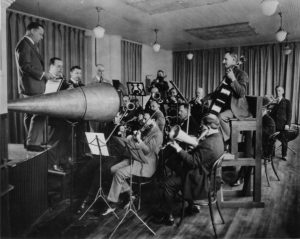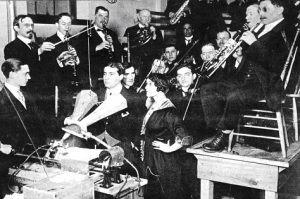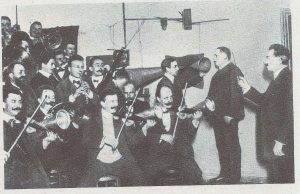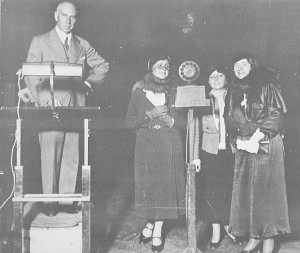 This page provides an introduction to the various eras of 20th Century sound recordings. You’ll find information on: Early Recording Methods, Acoustic Recording, Electric Recording, RCA Victor in 1947 & 1949, Long Playing Recordings, Andrew Walter on Transfers, New life for old recordings…By David Patrick Stearns, about Obert-Thorn & Marston, and Horst Wahl’s Essay on LL’s Rosenlieder. Wikipedia has a good page on the history of sound recording. Yale also offers information on the early years.
This page provides an introduction to the various eras of 20th Century sound recordings. You’ll find information on: Early Recording Methods, Acoustic Recording, Electric Recording, RCA Victor in 1947 & 1949, Long Playing Recordings, Andrew Walter on Transfers, New life for old recordings…By David Patrick Stearns, about Obert-Thorn & Marston, and Horst Wahl’s Essay on LL’s Rosenlieder. Wikipedia has a good page on the history of sound recording. Yale also offers information on the early years.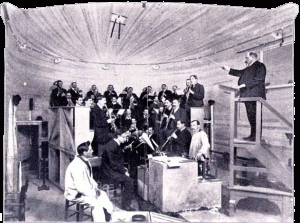
This first essay will introduce you to early recording techniques in a general way and, more specifically, how they related to Lehmann recordings.
It happens that the first demonstration of disc recording and reproduction occurred in 1888, the year of Lehmann’s birth. The cylinders Edison invented had been demonstrated as far back as 1877, but since Lehmann never recorded for cylinders, we’ll concentrate on discs.
Lehmann made her first recordings in 1914. To give you an idea of how early in the history of recorded sound that is, remember that the first singer of international fame to record on disc was Clara Butt and that was in 1899. Caruso, whose Victor recordings almost made the recording industry, sang his first recordings in 1903.
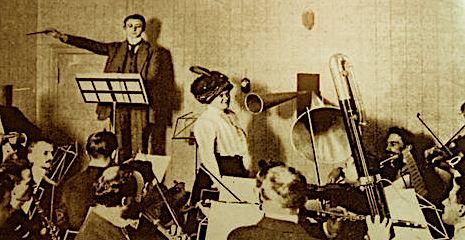
Not Lehmann but Frieda Hempel at the horn
Acoustic Recording: In 1914 the process was still fairly primitive, though the resulting sound was improved through the use of many technical advances. This was the “acoustic” process: no electric microphone was used. Instead there was a horn made of wood, (later stiffened fabric), that concentrated the vibrations of the singer and accompaniment down to the point of a needle which etched them into wax. There was no such thing as “splicing” a tape; if something went very wrong another “take” was required. The whole aria or song was recorded again. Some performers needed many “takes,” Lehmann seldom went beyond three and usually the first or second performance sufficed.
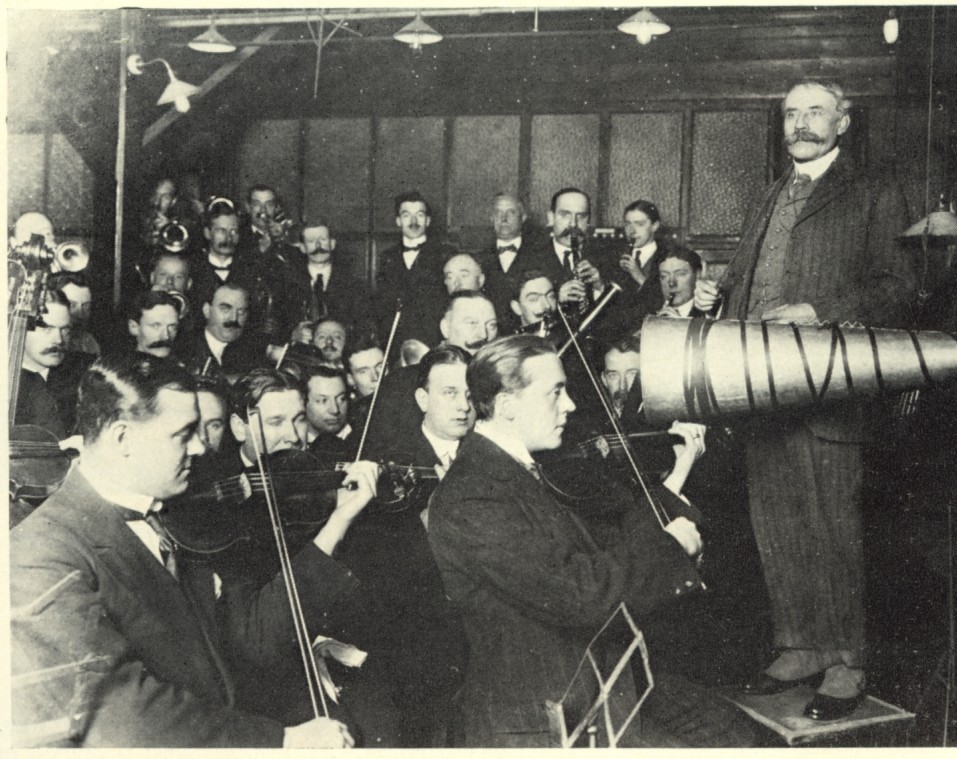
Edward Elgar conducting for an acoustic recording.
Though Lehmann’s first recordings, for Pathé, were issued on discs, the master was a cylinder. The sound from this was later transferred to disc. These first recordings had no paper label, but rather were etched with the information: “Lotte Lehmann, Stadttheater Hamburg”. Instead of the needle starting from the outer edge, these began in the center and moved outward. The rotating speed (revolutions per minute or rpm) was probably about 87 (sic).
We often hear the term “78s” when referring to early (pre-LP) recordings, but there was a great variance in the speed. If care isn’t taken when playing or transferring early recordings, the incorrect speed can change not only the pitch of the music, but the tonal quality of the singer. To add to the confusion, a label might state “78rpm” but have been recorded at 74rpm or even 72rpm. When played at 78rpm the result can be as much as a semitone higher! The correct “pitching” of an early disc is made more complicated by the fact the a true international tuning “A” wasn’t (and still isn’t) common. Further, the artist might not perform the piece in the original key. This was especially true for Lehmann at the end of her performing and recording career.
Another aspect of early recordings that must be considered when listening, is the limit in frequency range that could strip a singer of the richness of overtones (harmonics). The resulting sound can be “pure” or dull, depending on your perspective. Some singers, famous on the opera and concert stage, just did not sound good in the studio. Lehmann’s voice recorded well. Horst Wahl has written an account (below) of a Lehmann recording made at the end of the “acoustic” era.
Acoustical recording also preserved few silibants (s’s) and hard consonants (t and k) are difficult to identify. When listening to a song or aria with which we’re unfamiliar, it’s helpful to have the words or sheet music handy to better identify the words.
On another technical matter, let me quote John Steane from his book: “The Grand Tradition”. “Wear on the matrix is…insidious; the matrices of popular recordings deteriorated”. The matrix printed the “mothers” which printed the stampers which printed the consumer discs; the result of an overused, worn matrix was distorted reproduction. Further, inferior materials, such as the shellac used for the final product, forced the voice “to fight its way through a turgid hiss of surface noise that all but overwhelms it”.
One must also remember that the recording horn had its own acoustic properties, its own reverberation, which added to that of the singer. Thomas Stockham, Jr., an acoustician writes, “…the most serious defect is the resonant and reverberant quality given to the voice and musical instruments by the primitive recording horns used to focus the sound onto the original wax discs….Offensive loud bursts of sound also occur when certain tones are played or sung.”
The orchestras used for these early recordings were often banked around the recording horn on bleachers. The double bass (whose sound made the cutting stylus bounce) was replaced by tuba and the violins had amplifying horns built into their instruments. These strange looking contraptions were called “Stroh” violins, after their inventor.
The singer had to take care to sing into the very center of the horn and Lehmann remembered the producers making chalk marks on the floor. They were put there to remind her where she should stand at particular moments of the aria or song. To avoid distortion, or the needle jumping, she needed to retreat from the horn on certain notes or the loudest ones. (Lehmann referred to this as “more dancing than singing”). The result is that climaxes were altered because of this concern that the cutting needle might jump out of the groove or even break through to another groove. In spite of these limitations, we now marvel at the ability of the artist to concentrate on singing as they moved about and dealt with the other technical considerations.
Another artistic restriction was the limited length of a single “take”. There must have always been pressure to finish an aria or song within the four minutes available. This led to cuts being made or just a faster tempo. For a short song, an introduction might be composed. The famous critic of the times, Herman Klein, wrote of a recording where the contrast between the cavatina and faster cabaletta was spoiled. “The object of this was, I imagine, to bring the whole piece within the necessary time-limit, but that is no excuse for spoiling the music. It is infinitely better to make a liberal ‘cut’ than alter the character of the piece.” Do you see the choices that were available?
The few Lieder recordings that Lehmann made before the electric microphone was employed, used orchestra or added violin to the piano accompaniment originally intended by the composer. The result isn’t as annoying as the salon orchestras that accompanied her later electric song recordings.
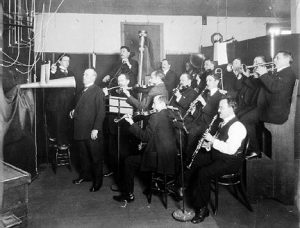 Even with surface noise and sonic limitations, there is still much beauty to be enjoyed from acoustic recordings. Our ears quickly adjust to the limits and learn to filter the surface noise and other distortions. Our appreciation for the historic moment is great. We are able to hear someone like Lehmann at the very beginning of her career. We are also able to hear singing traditions and styles of that period. The chance to compare Lehmann in early and later interpretations in recordings of the same aria or song is another blessing of these acoustic recordings.
Even with surface noise and sonic limitations, there is still much beauty to be enjoyed from acoustic recordings. Our ears quickly adjust to the limits and learn to filter the surface noise and other distortions. Our appreciation for the historic moment is great. We are able to hear someone like Lehmann at the very beginning of her career. We are also able to hear singing traditions and styles of that period. The chance to compare Lehmann in early and later interpretations in recordings of the same aria or song is another blessing of these acoustic recordings.
Electric Recording “Electric” recording emerged about 1925. “Electric” refers to the use of a microphone. Odeon was Lehmann’s recording company at the time. Because of patent restrictions on the microphone, Odeon was late taking up this new invention. By August 1926 when Lehmann recorded the “Rosenlieder” (see below) they finally were able to use a microphone. But Lehmann was unhappy with the result, which to her sounded metallic and tinny. There was, however, an alternative: the recording engineer, Horst Wahl, had invented a new recording horn made of stiffened fabric, which was, of course, the old acoustic method. Lehmann recorded the whole set of songs again. This time, even though with a horn instead of a microphone, it was, to Lehmann and Wahl, a better sound and it was this set that was published. To keep up with the competition the catalog and the record label listed this as an electric recording, but in fact it was still acoustic.
By February of 1927 Odeon was exclusively using the microphone and the resulting sound had improved. Finally the words, with all the enunciation for which Lehmann was famous, were able to be heard. Sadly, all the defects of the accompanying orchestras were also apparent! It is hard to believe that members of the Berlin State Opera Orchestra played so out of tune! Of course it wasn’t the whole ensemble, the conductors weren’t always first rate, there was no rehearsal time allowed and the acoustics of the recordings studios were primitive. But the poor intonation of the strings makes for distracting listening to many of these recordings and especially to an otherwise admirable recording that Lehmann made of Schubert’s An die Musik in 1927. This is only one example in which the accompaniment is bothersome to the listener over 70 years removed from the original recording. And the obvious indifference to intonation included the piano which was often untuned. It has been suggested that improper playback speeds and other technical matters might account for these intonation problems. If this was the case, why does Lehmann almost always sound in tune? The one exception, (Korngold’s Die Tode Stadt aria: Der Erste, der Lieb’ mich gelehrt…), in which Lehmann does wobble on the high ‘c’. It is strange that she allowed its release. The expression in the rest of the aria is remarkable and her low notes are very powerful, but the high ‘c’ screech is often what is remembered.
Earlier I mentioned the orchestrated accompaniments for the solo songs. It is useful to remember that the record companies assumed that their listening (buying) public might feel cheated with just the original accompaniment of a piano. Thus, the café orchestra, the salon orchestra or the instrumental trio often accompanied Lehmann’s early Lieder recordings. The in-house arrangers took liberties to “improve” on the harmonies of such masters as Schubert and Schumann. Added inner lines were often part of the process.
One of the now overlooked limitations of the recording after 1927 was the fact of one microphone. Whether a Wagnerian orchestra or a piano, the microphone was placed near the singer and the accompaniment was never the dynamic level we expect in a concert hall or opera house. The same limitations of about four minutes per record still obtained for electric recordings. In 1930 when Lehmann recorded her first Erlkönig, there is a rush to fit it all on one 10 inch disc when a 12 inch disc was needed. The pianist can’t manage the triplets and the result is very disappointing. During the electric recording era there was also both frequency and amplitude loss, though not to the same extent as with acoustic recordings. When Lehmann (or others) sang a loud climax, the engineers turned down the volume to avoid distorting. They sometimes overdid this, short-changing us some wonderful moments, but they were doing the best they could within the technology available at the time. (See Andrew Walter’s article below on transfers.)
When I interviewed Lehmann by telephone in her 85th year, I asked about the rehearsal for a recording such as the now classic Die Walküre with Bruno Walter conducting. Was there a lot of preparation, rehearsal and such? “Ach, no Gary. We knew it already!” was the response. And this was not unusual. For some reason there was a very casual attitude towards recording. It was seen as a “commercial” not an “artistic” endeavor. Lehmann herself remembers joking with her close friend Elisabeth Schumann, that they made some recordings this month “for a little extra mad money”.
Sometimes when the “78s” were transferred to LPs it was thought necessary to “improve” the sound with an echo chamber (resonance) effect. Also he effort to eliminate the hiss of the surface noise can wipe out the high harmonics of the voice. With CDs the problem of surface noise is often well handled, but there are those who hear a great loss in harmonics and overtones which gives a voice character.
Almost all of the arias that Lehmann recorded are in German, whether the original was in French or Italian or Russian. This may seem strange to us now, especially with supratitles available in most American opera houses, but in Germany and Austria the audience expected to hear the opera in their own language. This carried over into recordings and Lehmann (and others) sang French roles in German even in Paris!
Final RCA Recordings of 1947 & 1949 Now that Romophone has released the final commercial Lehmann recordings, there has been a renewed interest in the techniques that RCA Victor used in the late 1940s. Special interest has developed over the discovery of “test” pressings that, when compared to the published recordings, run a little longer or shorter and thus appear to be different “takes.” The test pressing generally has an “A” after the take number. Here is a report provided by Seth Winner: From 1945 to 1947, when they were still cutting matrices, a ” -1″ matrix signified the prime cutting lathe used; a “-1A” signified the alternate prime cutting lathe. (In other words, the backup lathe.) ” -1B”, “C”, signified another set of backup lathes, in most instances, where they cut lacquers, as they did on the prime and alternate prime machines, but did not have those discs sent out for plating, unless there were defects in the prime and/or alternate prime sources. It is up in the air about whether the different sets of cutters were hooked up to separate mikes…I doubt it. What you are probably hearing in the “-1” vs. the “-1A” copies is due to a number of factors:
1. The difference in frequency response between the two cutter amplifiers,and
2. If the “-1A” starts and/or ends at a different time than the “-1”, this is due to the machines starting up and/or being shut off manually at different times by the engineers manning the lathes….or, the lathes were running at different speeds!!! This can happen too, you know.
From 1949 on, they are mastering on tape. “A -1” matrix signifies an approved take for PRODUCTION. (in other words, the approved take may have been the 2nd, 3rd, 4th, or what have you that the artist did in the recording sessions, but when it went into production for remastering, the final edited equ’ed version was assigned a TAKE 1 for release.) Sometimes, a “-2” may pop in..This was a second attempt at making a production master for release.
By the way, the 45’s were dubs of either 78 rpm matrices prior to 1949, or tape dubs, after 1949. [Several of Lehmann’s final recordings were issued in 45rpm format.]
If I’m correct, there is a rather messy edit in the issued version of Lehmann’s “God Bless America”…This was the result of trying to slip-cue parts of two different takes. I bet you the matrix number on that one may have a -1R or -1G, or -1H…Sometimes the higher letters signified a dub..the -1R signified a recut or dub, in the early days of RCA…..
So wrote Mr. Winner. Still some questions remained: What does the “test” pressing or “proof” mean? Is it the actual lacquer cut at the time of the recording? And, on a slightly different topic, before tape was used, did they still use soft wax for the main recordings?
Mr. Winner replies: I just spoke to my contact again, he is not sure what these proofs are…If they are lacquers, then they could be dubs from the metal parts for review purposes, or indeed an orginal set of lacquers cut at the sessions for review purposes…If they are pressings, then they are simply test pressings. From what he could tell me, the metals were made from wax…only the lacquers were cut as protection on the additional cutters…
Long Playing Recordings Though Lehmann didn’t record in the age of the microgroove, her Columbia radio broadcasts of 1941 were disseminated by mail (remember this was before the age of satellites) by 33 1/3 vinyl discs that were 16 inches across. A set of these recordings was discovered in 1988 and since then it has been released on both LP and CD formats. These recordings suffer the same limitation of a single microphone placement which didn’t capture the balance with the piano. Also, the early microphones didn’t reproduce with the kind of fidelity we expect today. The major benefit, however, is the quiet surface that doesn’t have to be filtered to be enjoyed. By the way, Lehmann introduced the songs with sometimes telling commentary.
Here is an article by the (un-named) producer of the Pearl CD 1998 release of Lehmann’s Winterreise: “For both record collectors and Schubert enthusiasts the 1941 Die Winterreise sets from Columbia and Victor have been problematical. Being split between three different sets was bad enough, but the real problem is that the records did not follow the right order. A typical example is one of the Victors (17190) which has on side A, no. 5 and on side B. no. 17 followed by no. 8! In fact the songs are split in no particular order except that possibly they were designed to fit onto the sides allocated. It is no surprise to learn that these sets were not available in the UK, EMI preferring to issue its own complete sets with Gerhard Hüsch (now on GEMM CD 9469). The Lehmann sets are to be treasured as wonderful interpretations by a supreme artist, and now of course with the extended playing time of the compact disc, the whole song cycle can be heard at one listening and in the correct order.
“There were other problems in which the sets were made. Whilst the Victor set is overall well recorded, the Columbias are very variable; one side can be very immediate, its partner rather dull and thin. The explanation is in Columbia’s system of recording its masters on acetates in addition to original waxes. For one reason or another, the original would prove unsatisfactory and a fresh wax was made by playing the acetate and feeding the signal into the recording lathe. This dubbing process was only as good as the replay system then available: there is the occasional hint of distortion especially toward the end of sides, something absent from the Victor sides. Apart from the losses inherent in such a process, pitch variation in the replay turntable can rear its ugly head. In this instance there were a few difficulties with one side rising in pitch by nearly a quarter tone after the first note; this has been corrected. The piano also seems to have had some tuning problems although again this may be speed fluctuation on the replay turntable, particularly as it effects the beginning of sides when the weight of the pickup would have had its greatest effect: we are talking ounces and not grams. I have no doubt that Lehmann approved the originals and was not given the opportunity to vet the transferred sides.
“Obviously there are differences in sound between the three sets but these have been minimized as far as possible as have the inevitable changes in character of the remaining surface noise, although not at the expense of the recorded sound.”
So writes the un-named Pearl recording engineer.
Though, of course, the producer of the CD in consideration had his own point of view to promote, the listener can verify his comments as to the results.
Lehmann did actually record in the LP format, but this was after she stopped singing. Her two albums of German lyrics and poetry are cherished by all who enjoy hearing her active interpretations.
As CD transfers have improved, we hear more and more of Lehmann and less of the intervening technology. CDs have also allowed us to hear Lehmann’s complete recording of Winterreise mentioned above, which was originally recorded for two different companies and not available on LPs outside of Japan. Lehmann said that she regretted that very much. She must have been proud of her accomplishment in this cycle and would be pleased that a number of companies have released it complete.
Andrew Walter on Transfers In the Summer 1997 issue of ICRC, (International Classical Record Collector magazine), Andrew Walter, a sound technician for EMI writes about “improvements” from historic recordings to the CD medium: “The aim is not only to reflect the original recording accurately, but to provide the best possible sound for the medium of CD, within the parameters and integrity of the original. To me a ‘remaster’ is a rediscovery of history, an archaeological excavation of musical methods, styles and experiences that are put on to CD in such a way that they can…accurately reflect the original integrity and quality of the recording….
“These archive masters exhibit,…the best possible representations of an artist, using the best recording technologies available at the time…
“[V]arious sound alterations do prove to be essential when transferring to the digital medium. These relate to the differences in reproduced sound between a 78rpm record player or LP player and a modern digital CD player. Such vast improvements have been made during the past century in the amount of frequency and dynamic range that can be recorded and reproduced, that a direct transfer of a 78rpm record on to CD will appear actually to accentuate the clicks, crackles and broadband surface noise of a shellac record. This is simply because the reproduction and full frequency range output of a modern system is far more effective a reproducer than was ever intended or possible for this type of recording. Early 78rpm recordings were so limited in their frequency bandwidth, the limitation resulting from the early horns and microphones, that the aural frequency gaps are filled in with white noise on modern reproduction.
“When a 78rpm record is reproduced on a 78rpm gramophone player, the clicks and surface noise are less audible as a result of the limiting reproduction and natural filtering effect of the horn and resonating sound board. Representing on CD but also retaining the original recording engineer’s achievements from the 78rpm matrix, is for me the ‘thin blue line’ between respecting their best possible recording techniques and latterly deciding to improve upon their art. Therefore, when remastering on a modern reproducer, any ‘extra’ frequency noises that are the result of the modern transfer process need to be filtered away, so that the sound matches that originally produced from a gramophone player, although of course this procedure has to be balanced against the advantages of extra recorded frequency information that can be picked up on a more modern 78 player.
“The clicks, pops and scratches and ‘reasonable’ amounts of the broadband surface noise can nowadays be taken away without damage or effect to the original recorded content”. (But Walter warns against overdoing this and losing the “life, presence, warmth and character of the original”.)
“Of fundamental importance…is to obtain the very best source material. This, more often than not, is the original metal positive or ‘mother’ from which the stampers were produced that pressed the 78rpm shellac records; a generation much closer to the original wax disc and made of metal and not shellac composite, they do not display anything like the imperfections that a 78rpm record does. The metal positive, compared with a shellac pressing, is astonishingly quiet and relatively click free. Interestingly, during the history of 78rpm remastering within EMI, previous transfer engineers have used metal positives and also pressings of these positives in vinyl material, which can often be more ‘user-friendly’. Where metal parts have survived, they do not always play perfectly—especially, for example, if they have become warped; but where possible, I have found that it is preferable to transfer from the closer generation metal positive, rather than a vinyl pressing of that positive, to avoid any alterations in sound quality that may be evident from replay of a vinyl pressing, especially given the remastering technology now available….
“I have often made comparisons between the metal master and the shellac pressing and the sound displayed on the metal positive is like that expected from a recording made 20 or 30 years afterwards! It is evident, therefore, that although the 78rpm record did not make for quiet reproduction, it did lend itself to mass production and hence the compromise was allowed….
“Obviously, like all transfer engineers and record enthusiasts, I find that choosing the most suitable stylus for transferring a 78rpm recording is important and one’s choice can significantly alter the character of the recorded sound….I like to choose a stylus not necessarily by the age of the recording but rather by the resultant sound effect it will achieve. I often change a stylus during the transfer of a side, particularly if excessive wax wear or ‘cold wax chatter’ (the cooling of the cutting wax) becomes evident. Despite the available science, cyclic swish is still a problem, although varying the stylus can often minimize this effect for the listener.
“The other consideration, while transferring, is the gently sloping equalization effect towards the end of the recording on some cuts. This is caused by the lack of groove area available towards the end of the side in relation to the smaller distance covered by the cutting stylus. To get around this problem, higher-frequency equalization filters need to be used when transferring towards the end of a side to compensate for the effect. [I might add, that with vocal music, the end of the side can also correspond to the climax of the aria or song and thus a high note, which more readily distorts in this portion of the original disc.] A realistic transfer is also reliant upon a good understanding of pitch. The 78rpm cutting machines did not always run at 78rpm. I recently transferred…recordings, made in Cairo during the 1930s…one of the matrices ran as slowly as 62rpm!
“The other problem of pitch relates to the actual pitch recorded at the session. Many famous singers have been known to transpose arias down to suit their vocal state on a particular day….To face a combination of these problems of turntable revolutions and relative pitch can present quite a dilemma…
“Once all the conditions for transfer are acceptable, the transfer can be made via 20-bit digital processing to computer hard disks. The sound can then be digitally cleaned up without fear of any further degradation….
“It is impossible at present, I believe, to remove all of the surface noise from a 78rpm recording without detriment to the sound…Until science can artificially expand the recorded sound on 78rpm reocrds with ‘pseudo-harmonics and frequencies’, a good transfer will always rely on degrees of high-end frequency noise to compensate for the human being’s aural expectations….
“[B]y rediscovering and preserving the past on CD, we can allow newer generations of music-lovers to judge and appraise proportionately what is to come, and, surely that can be no bad thing.”
So writes Andrew Walter, a sound technician for EMI.
New life for old recordings…By David Patrick Stearns INQUIRER MUSIC CRITIC “I hear dead people.”
You could say that especially in Philadelphia. More clearly than ever – and with no need for extrasensory powers – musical voices from the past are being kept alive behind two particular closed doors, one on a Victorian, tree-lined avenue in Swarthmore and the other in a spanking-new North Wales subdivision.
Ward Marston, a jazz pianist who also issues compact discs of long-dead opera stars from his Swarthmore home, and Mark Obert-Thorn, a cost-accounting specialist for Verizon who refurbishes Jascha Heifetz recordings in his North Wales den, would conventionally be called aural preservationists. But their admirers would call them rescuers of endangered musical species. Most of their output has been performances recorded since the advent of microphone recording in 1925, but they sometimes dip into the shadowy world of discs and cylinders made as early as 1901, when many now-classic composers were still alive.
Sometimes they publish recordings, by major musical artists, of which only a single known copy survives.
All of which may sound a bit arcane, except that Marston and Obert-Thorn, two of perhaps a half-dozen people in the world who do this kind of work, are key players in classical music’s latest trendlet: the greatest recordings of the past, available in the best-ever sound at super-budget prices. Discs with Sergei Rachmaninoff, Enrico Caruso, Yehudi Menuhin, Leopold Stokowski, and other deceased giants – in big, bold, mesmerizing performances, as refurbished by Marston and Obert-Thorn – are selling as many as 30,000 copies each. That popularity is nothing mysterious.
“It’s an approach to music that just doesn’t exist now,” said Obert-Thorn. “These recordings offer something people can’t get anywhere else.”
“I don’t want to sound smug . . . but nowadays when I go to hear the Philadelphia Orchestra – and I go all the time – the climate is such that conductors do less and less with their own interpretation of the music,” Marston said. “There’s not much out there now that’s of compelling interest.”
Music lovers now need invest only $5 to $7 to hear extravagant musical personalities whom they’ve only read about. That’s thanks mainly to Obert-Thorn’s suggestion of such an endeavor to Naxos, the Hong Kong-based label that shook up the classical industry a decade ago with super-budget CDs made possible by low overhead and a huge international distribution system.
Although Obert-Thorn’s friends give him grief about working for a budget label, he and Marston, as much as anyone else, labored for years to build the public’s taste for recordings such as these. In 11 years, Obert-Thorn has remastered 200 CDs’ worth of old material for any number of independent labels. Marston’s own label has put out 34 discs. For other companies large and small, Marston has remastered a total of 500 CDs. He has won a Grammy award for best historic recording and was nominated three other times, including this year for RCA’s huge Rubinstein Collection, for which he remastered all of pianist Artur Rubinstein’s 78-r.p.m. recordings.
Payment for each CD is $750 to $1,500, just enough to cover the cost of acquiring rare recordings and the esoteric technology to make them sound better. That degree of commitment doesn’t go unrecognized. One of Obert-Thorn’s admirers built a multipage Web site in his honor. Marston receives deeply grateful letters. “It’s like applause,” he said. “It keeps me wanting to do it.”
That two such super-specialists emerged in a city where past and present meld is more than coincidence. One of the world’s most idolized dead conductors is Stokowski, for 25 years the music director of the Philadelphia Orchestra. “And we happen to be next to Camden, which [because of a major RCA-Victor plant] was the center of the classical recording world in the teens and ’20s. So there are many pressings of discs to be found,” Obert-Thorn said.
Outwardly, the two remasterers would seem to have little in common. Obert-Thorn is a soft-spoken, reserved family man. The extroverted Marston lives in a bustling household full of friends and wisecracking assistants who help him live a high-functioning life despite being blind.
Their closeness in age – Obert-Thorn is 44, Marston 48 – is significant: They’re just old enough to have caught wind of these artists as they were receding from public memory.
Both went to Williams College, in Massachusetts. Marston was a student there four years earlier, and his name was on the library checkout cards for all of Obert-Thorn’s favorite recordings of long-dead artists. Then Obert-Thorn happened upon Marston’s voice on WHYY-FM in the mid-1970s during a program about Stokowski. The former tracked down the latter, and they now manage to be friends, rivals and collaborators, bargaining with each other for different remastering projects and making trades out of their collections, since two climate-controlled basements full of 78s (Marston has 30,000; Obert-Thorn 5,000) are always better than one.
Luckily, they have complementary specialties. Obert-Thorn veers toward instrumentalists. Marston loves lost opera-singing traditions, even when that means wrestling with 131 2-inch French discs that were made in 1912 and play at 90 r.p.m., with the tone arm traveling from the center of the disc out to the edge. He also earned the world’s gratitude by publishing a rare set of pristine test pressings of Wagner’s Tristan und Isolde recorded live in London with Kirsten Flagstad and Lauritz Melchoir, and roundly acclaimed as the best performance ever of the opera.
The two typify a noninvasive approach. Although all sorts of electronic fairy dust can be sprinkled on a recording to “improve” it, they prefer to make the best of what’s in the grooves. That’s lucky, since professional friendships are easily broken in this world, when last year’s technological breakthrough becomes this year’s bete noire.
Recording buffs who aren’t building cyber-monuments to Obert-Thorn are sometimes out to demolish him. His antagonist these days is Michael Dutton, a seasoned record producer who has his budget-priced, historical label, Dutton Lab, in England. Dutton exemplifies the opposite restoration approach, using all manner of means (some are secret) to make recordings sound as if they were made yesterday.
Don’t even think about disagreeing when Dutton is on the other end of a transatlantic phone line and starts questioning Obert-Thorn’s authority: “Has he had formal training as an engineer? Where do his qualifications lie as a producer?”
The less-incendiary, self-taught Obert-Thorn replies that refurbishing old recordings is a completely different skill from making new ones: “When you work with a historic recording, you have to work with what you’re given there. You can’t change a microphone placement.”
Marston’s main critic is himself. When a friend delivered a 78 transfer that was better than his own, Marston went into a crisis that resulted in a more conservative approach toward noise filtering: “I’m like an ex-smoker. I can’t stand people who filter. You have to do some, but you first have to find out what [sound] is up there [in the high frequencies] first. I’m rabid about it!”
So it goes in the always uneasy meeting of archaic and current technology. Certain types of 78-r.p.m. styli are so rare you can only hope to send old ones to a small company in England that retips them. However, scratches and clicks can now be removed via the ultra-high-tech Cedar System, which doesn’t filter but replaces the unwanted noise with a nanosecond sound sample taken from the recording. When such machines were $15,000, Obert-Thorn and Marston had to send their tapes off to New York for the Cedar treatment, guessing at knob settings. Now prices are down; they own one.
From there, the procedure is fairly simple: Find good pressings of the recording, experiment with turntable speeds (many 78s are in fact 74s), find the stylus that best rides the grooves, edit together the breaks between sides, and maybe add a touch of reverberation (a technique to which Marston is a slow, hesitant convert) for performances that seem to have been recorded in a shoe box.
Like most retrospective arts, this one is haunted by the possibility that the past will run dry. How many more great recordings of the past are left to exhume? As far as commercial ones are concerned, not many.
But unpublished radio tapes keep turning up. One of pianist Mieczyslav Horszowski’s best live recitals was found in a trash barrel at the Vatican. Pianist Ignaz Friedman recorded his entire repertoire for Australian radio during World War II, but the tapes were used as landfill in the building of a superhighway. Might those be excavated one day?
Naxos plans first-time publication of 1940s radio broadcasts that were sponsored by Standard Oil. Three unpublished live opera recordings from Buenos Aires have just been acquired by Marston, including a dream cast of Wagner’s Parsifal, conducted in 1936 by the great Fritz Busch.
And who knows what future technological breakthroughs might keep music lovers repurchasing their favorite performances? Much of what is now available was unthinkable 15 years ago. Marston believes he will live to see a time when old Caruso recordings sound new. “Given what has happened over the years,” he said, “I can’t imagine why not.”
LL’s Recording of the Rosenlieder by Horst Wahl
To my great joy I have discovered that some of my earliest professional recordings, produced more than 64 years ago for the Odeon recording firm, have just been resurrected on a compact disk. Lotte Lehmann’s interpretation of the “Rosenlieder” of Count Philipp zu Eulenburg [and Werner’s song] are on Pearl GEMM CD 9409. Werner’s Heidenroslein
Eulenburg (1847-1921) belonged to Kaiser Wilhelm II’s closest circle of friends and was elevated to the rank of prince in 1900. His hobby was the composition of songs in the folk tradition, and his “Rosenlieder” cycle enjoyed great popularity in the period just before the first World War. As it did not present great difficulties in its vocal, piano or violin parts, it was often quite satisfactorily performed during evening soirées by music-loving amateurs.
At the time the “Rosenlieder” recordings were made, on August 5, 1926, I was still quite a young man and had been employed a year and a half on the retail sales staff of Odeon. My acquaintance with Lotte Lehmann began in May of 1925 when the artist entered our retail outlet on Leipziger Street in Berlin one day to listen to a few new recordings of prominent sopranos. Although I was, of course, quite familiar with her appearance in photographs and on the Berlin Opera House stage, I did not immediately recognize her as she was wearing the latest rage in women’s hats of the period. It was rather a pot-like affair and covered her face down to the eyes. When she asked me which sopranos I would especially recommend, I replied with cool placidity and the deepest certainty, “Well, if you ask my opinion, madam, there is only one–Lotte Lehmann. She is the greatest of them all.”
You can well imagine how such a young coxcomb as I might have felt when from under the stylish helmet came the vigorous reply, “Thank you, young man, that is who I am.”
There have been few times in my life as perplexed and confused as those moments. I might as well have been struck by lightning. From this moment on began a deep friendship which lasted for ten years and which belongs to the most wonderful experiences of my long life.
I had at that time a sound studio in Berlin on Augsburger St., where for three years I had produced for the private use of my customers, acoustic recordings on zinc, acetate or other synthetic materials. Among my clients were such important singers as Joseph Schwarz, my neighbor; Meta Seinemeyer, Sabine Meyen, Hedwig Francillo-Kauffmann, Margarethe Matzenauer, Michael Bohnen and Alexander Kirchner.
When I mentioned this sideline occupation to Lotte one day, she immediately decided to test her voice on my equipment. Among the test recordings were duets which we sang together, (I had studied voice with Prof. Bernhard Ulrich), among them the “Rosenlieder” of which we were both especially fond.
As we listened to these recordings, the sound of her voice and also of the accompanying piano was so remarkably natural sounding by acoustic recording standards of the day, that she asked me if this lieder cycle might not be commercially produced by Odeon.
At that very time, a major technological change was rolling through all recording firms: electric recording. Odeon had already taken its first steps in this direction, and it appeared as if the “Rosenlieder” with its simple piano and violin accompaniment would be an ideal test.
During the first electric recording session with Lehmann on August 2, 1926, I was otherwise employed and not at hand. Three days later we (Lotte, Dajos Bela, Mischa Spoliansky, Georg von Wysocki, Odeon artistic director, and myself) listened to the sample recordings.
It was sadly obvious to all of us that the electric microphone had not done justice to either Lotte’s wonderful voice or Dajos Bela’s lovely violin. Both came over the loudspeaker with much too sharp a sound.
After a conference with the management of the firm, Lotte was able to get permission for me to record these songs acoustically, using my own methods. To this end I then brought to the Odeon studio my own large horns, one for the singer and one for both accompanists.
Whereas the Odeon Trichter [horns] were made of cloth, the horns I had made for myself were of metal wound with insulating tape to prevent self-vibration. The larger diameter of these horns allowed the singer to come so near the device that occasionally her head would project into it. Happily for me, the calm and not overly tempestuous nature of the music worked all to the good, and most of the danger of “blasting” was avoided.
Lotte Lehmann signed the release for publication of the “Rosenlieder” on December 14, 1926. This lieder cycle was first offered to the public in March of 1927 under the errant nomenclature “Electric Odeon Recording,” and in succeeding years, due to its high quality, it continued to be listed in all the catalogs as “electrically recorded.”
Mischa Spoliansky, like Lotte Lehmann, lived a long life, and even in his late 80s appeared on German television recounting incidents of his artistic life.
In these songs Lotte quite consciously used a short and frequent taking of breath as a medium for musical expression, evoking her passionate presence. Instead of the higher range usually found in her other recordings, her voice moved here within a quite enchanting mezzo range.
If I allow a little self-praise here, the reproduction of the original “Rosenlleder” belongs to the best of acoustic recordings and is nearly impossible to distinguish from early electrics. Voice and accompaniment are both well balanced. The clearly audible breath brings the singer to vivid life before us. The current reissue on compact disk presents the first publication of the “Rosenlieder” since they were issued on 78rpm shellacs.

